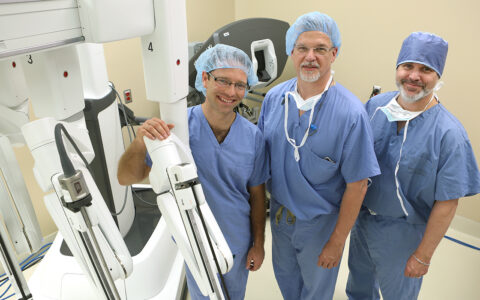Five-year results from the Comparative Effectiveness Analysis of Surgery and Radiation (CEASAR) study, recently published in JAMA, provide new evidence on the long-term physical and mental effects of prostate cancer treatment with radiation, surgery or active surveillance in patients of all ages and ethnicities.
“We are providing updated information about the side effects of different treatments so that men and their providers can use it to make treatment decisions,” said Daniel Barocas, M.D., associate professor and vice-chair of the Department of Urology at Vanderbilt University Medical Center. Under Barocas, the CEASAR study has now been extended to revisit participants ten years later.
“There is more to a treatment decision than just the side effects, the most obvious being the effectiveness of the treatment,” Barocas said. “We are going to compare the available treatments with respect to how many of the participants are still alive, how many have had a cancer recurrence, and how this disease and its treatment have affected their quality of life and finances.”
“There is more to a treatment decision than just the side effects, the most obvious being the effectiveness of the treatment.”
Building on Previous Results
The original six-site study included men diagnosed with localized prostate cancer, diagnosed in 2011 or 2012. The favorable-risk group chose active surveillance, nerve-sparing prostatectomy, external beam radiation therapy (EBRT), or low-dose-rate brachytherapy. The unfavorable-risk disease group chose either radical prostatectomy or EBRT.
Earlier results showed that radical prostatectomy was associated with greater declines in sexual function and urinary incontinence than external beam radiation or active surveillance. Radical prostatectomy was also associated with fewer urinary irritative symptoms than active surveillance.
In reporting five-year outcomes, researchers looked at 1,386 men who had favorable-risk prostate cancer and 619 men with unfavorable-risk prostate cancer to evaluate the impact of their treatment decisions on urinary, sexual and bowel function.
Sexual Function at Five Years
“For sexual function, all of the treatment options, even surveillance, were associated with significant declines,” Barocas added. “While the time course is different for surgery and radiation, our study shows that only about half of men undergoing these treatments who had erections good enough for intercourse before treatment will still have an erection good enough for intercourse five years later.”
Urinary and Bowel Function
Prostatectomy was associated with worse incontinence compared to other treatments for both the favorable-risk and the unfavorable-risk groups. At five years, 10-16 percent of men who had surgery reported a moderate or big problem with leakage, compared to only four to seven percent of men who had other treatments.
Men undergoing radiation reported worse urinary irritative and obstructive symptoms within the first six to 12 months, particularly those undergoing the low-dose rate brachytherapy. However, these urinary symptoms largely returned to baseline after one year.
“If you look at the side effect profile for external beam radiation, most of those men after a year have rebounded in terms of their urinary and bowel function, which is a novel finding of our study,” Barocas said. “The brachytherapy patients have a more difficult time with the urinary and bowel symptoms in that first year.”
Informing Patient Decisions
To help inform patients’ expectations and choices about treatment, the researchers have developed a personalized, Web-based prediction tool that allows men to enter their own data and compute their chance of regaining bowel, bladder or sexual function.
“This work provides critical and understandable information to patients and providers to help them make better decisions in localized prostate cancer,” said David Penson, M.D., chair of the Department of Urology at Vanderbilt.
Karen Hoffman, M.D., of MD Anderson is the lead author of the five-year report.





